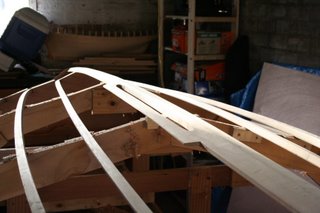
The time has arrived to start planking! Here is the first plank going on the boat which was quite exciting as once I get through this stage I will have something that will float (hopefully).

The process went without a problem in the end and the plank pulled down quite well. The twist at the front is quite extreme so I took it slowly and ensured that it was supported with a clamp as I was concerned that the pressure on the end screw might pull it through the plywood.
Here is a shot from the inside of the forefoot. As you can see the plank pulls down well on the keel bevel and creates the illusion of the keel sinking into the plank.

The part that concerned me the most was the scarf joint. I will have few more pictures of this in the next post.
Lessons learnt from this stage would be to watch where you put the screws at the keel. This is a fine line between getting them too close to the side of the keel and going right through and having them too close to the center and ending up with them interfering with the bevel for the other garboard plank and the flat for the deadwood.

In the end mine where to close to the centre so I removed all of the screws that where going to cause a problem. Luckily I discovered this about 18 hours after gluing on the plank so I could remove the screws before the epoxy held them for good. At this stage I don’t think I will replace them as I can’t see them adding that much to the strength of the joint. I will check this with Arch and see what he thinks.













